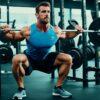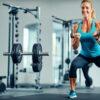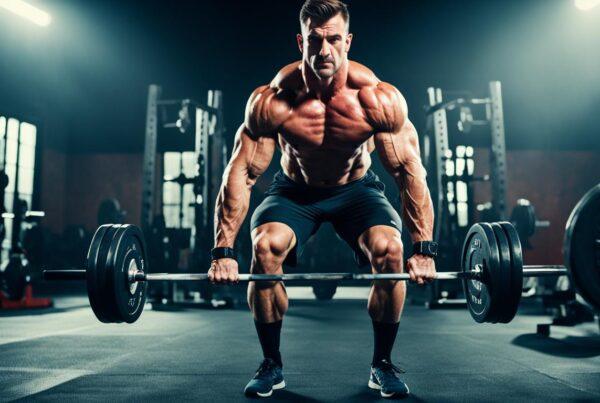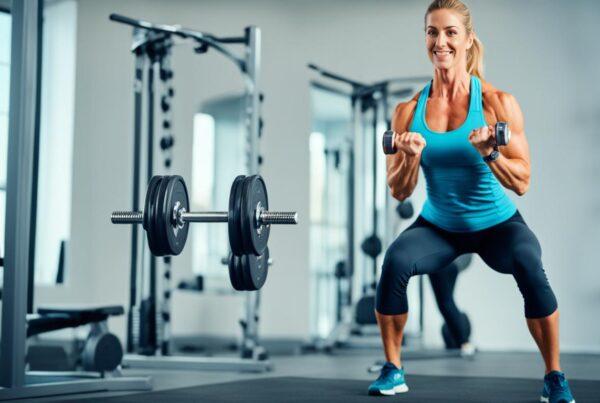Training your quadriceps is crucial for achieving optimal leg growth and developing a well-rounded physique. However, many people make common mistakes in quad training that can hinder their progress and limit their gains. In this article, we will discuss these mistakes and provide you with tips on how to correct them, allowing you to maximize your leg growth potential and minimize the risk of injuries.
Key Takeaways:
- Proper form is essential in quad training to effectively target and activate the quadriceps.
- A thorough warm-up routine is crucial to enhance quad activation and overall workout performance.
- Performing exercises with a full range of motion is necessary for optimal quad activation and muscle growth.
- Ensure balanced development by incorporating hamstring exercises in your training routine.
- Good nutrition is vital for supporting muscle growth and maximizing the benefits of quad training.
Importance of Training Quads for Overall Physique
Developing well-rounded leg muscles, especially the quadriceps, is essential for creating a balanced and impressive physique. Neglecting quad training can result in an asymmetric physique and hinder progress in other exercises like deadlifts and squats. Strong quads serve as the foundation for optimal athletic performance and overall strength. By prioritizing quad training, you can improve the aesthetic appeal of your physique and enhance your overall fitness level.
When it comes to leg workouts, focusing on quad training is key to achieving leg gains and overall muscle development. The quadriceps, which consist of four major muscles, are responsible for knee extension and play a vital role in various lower body movements. Neglecting quad training can lead to muscular imbalances, compromising your athletic performance and overall leg development.
Did You Know?
Training your quads not only enhances the aesthetics of your legs but also improves functionality and stability in daily activities. From walking or climbing stairs to participating in sports, strong quads are essential for optimal performance and injury prevention.
By targeting your quads during leg workouts, you can achieve well-proportioned leg muscles, increase your overall strength, and enhance your power output in various activities. Whether your fitness goals include building muscle mass or improving athletic performance, don’t underestimate the importance of quad training.
Benefits of Quad Training:
- Improved Leg Aesthetics: Focusing on quad training helps build well-defined leg muscles, giving your legs a sculpted and aesthetic appearance.
- Enhanced Athletic Performance: Strong quads provide the power and stability needed for explosive movements like sprinting, jumping, and changing direction quickly.
- Increased Strength: Strengthening your quads enhances your overall lower body strength, enabling you to lift heavier weights in exercises like squats and lunges.
- Lower Body Functionality: Well-developed quads contribute to improved balance, mobility, and overall functionality in daily activities.
Make quad training a priority in your leg workouts to achieve optimal leg gains and overall muscle development. Keep in mind that proper form, adequate rest and recovery, and progressive overload are essential for maximizing the benefits of quad training.
Top Quad Exercises for Leg Gains
| Exercise | Description |
|---|---|
| Squats | A compound exercise that targets the quads, glutes, and hamstrings. Perform with a barbell or dumbbells. |
| Lunges | A unilateral exercise that works the quads, hamstrings, and glutes. Perform walking lunges or stationary lunges. |
| Leg Press | An effective machine exercise for targeting the quads. Adjust the seat and foot position for optimal quad activation. |
| Leg Extensions | An isolation exercise that directly targets the quadriceps. Focus on controlled movements and full range of motion. |
| Step-Ups | A functional exercise that engages the quads, hamstrings, and glutes. Use a bench or elevated platform for step-ups. |
Remember to include a variety of quad exercises in your leg workout routine to target all areas of the quadriceps muscles. Aim for proper technique and gradually increase the intensity and workload over time to continue making progress and achieving leg gains.
Common Quad Training Mistake: Improper Form
One common mistake in quad training is using improper form. Many individuals fail to execute exercises correctly, which can reduce the effectiveness of the workout and increase the risk of injury. For example, improper squat form can lead to excessive stress on the lower back muscles instead of effectively targeting the quads. It is crucial to learn the proper form for quad exercises and focus on executing each movement with precision and control to maximize quad activation and minimize the risk of injury.
Proper Form for Quad Exercises
Executing quad exercises with proper form is essential for engaging the targeted muscles effectively. Here are a few tips to ensure correct form and maximize the benefits of your quad training:
- Keep the knees aligned with the toes: During exercises such as squats and lunges, it is important to maintain proper alignment between your knees and toes. Avoid letting the knees cave in or collapse inward, as this can strain the knee joint and shift the focus away from the quads.
- Maintain a neutral spine: To avoid excessive stress on the lower back, it is crucial to maintain a neutral spine position throughout quad exercises. Avoid rounding or arching your back, as this can lead to poor form and potential injury. Focus on engaging your core and maintaining proper posture while performing the movements.
- Control the range of motion: In quad exercises like squats, leg presses, and lunges, control the descent and ascent of the movement. Avoid bouncing or using momentum to power through the exercise. By maintaining control throughout the entire range of motion, you can ensure optimal quad activation and prevent unnecessary strain on other muscles.
- Engage the quads: During quad exercises, such as leg extensions or leg presses, consciously focus on contracting and engaging the quad muscles. Visualize the quad muscles working and strive to feel the burn in the targeted area. Mind-muscle connection is crucial for maximizing quad activation and overall leg development.
Improper form not only limits the effectiveness of your quad training but also increases the risk of injury. By paying attention to your form and executing each quad exercise correctly, you can target the right muscles, enhance quad activation, and minimize the likelihood of setbacks in your training journey.
To further illustrate the importance of proper form, consider the table below, which compares the activation levels of the quadriceps with correct versus incorrect squat form:
“`html
| Correct Squat Form | Incorrect Squat Form | |
|---|---|---|
| Quad Activation | High | Low |
| Lower Back Activation | Low | High |
| Knee Stress | Evenly Distributed | Excessive |
“`
The table clearly demonstrates the importance of proper form in targeting the quads effectively while minimizing stress on the lower back and knees. By focusing on executing quad exercises with correct form, you can optimize your training outcomes and reduce the risk of injury.
Remember, developing proper form is crucial for effective quad training. Prioritize precision, control, and alignment in your exercises to ensure maximum quad activation, minimize the risk of injury, and propel your leg growth to new heights.
Common Quad Training Mistake: Insufficient Warm-Up
When it comes to quad training, a mistake that many individuals make is skipping or not adequately warming up before their workout. The warm-up phase plays a crucial role in preparing your body for the upcoming training session, ensuring optimal performance and reducing the risk of injuries.
A proper warm-up routine helps increase blood flow to the muscles, enhancing their functionality. It also promotes joint mobility and flexibility, allowing for a full range of motion during exercises. By neglecting the warm-up, you hinder your quad activation and compromise your overall workout performance.
To avoid this mistake, incorporate a dedicated warm-up into your quad training routine. Start with light cardio exercises like jogging or cycling for a few minutes to elevate your heart rate and warm up your entire body. Afterward, incorporate specific dynamic stretches and activation exercises that target your quadriceps.
Here’s an example of a warm-up routine that you can try:
- 5 minutes of light cardio (jogging, cycling, jumping jacks, etc.) to increase heart rate.
- Dynamic quad stretches: Perform 10-15 reps of walking lunges, focusing on stretching your quads with each step.
- Activation exercises: Complete 2 sets of 12-15 reps of bodyweight squats, focusing on squeezing your quads at the top of each rep to activate the muscles.
- Stretching: Finish with static stretches for your quadriceps, holding each stretch for 20-30 seconds.
By including a proper warm-up routine that targets the quadriceps, you prepare your muscles for optimal training and set the stage for maximum quad activation and growth. Don’t underestimate the power of a good warm-up! It can make a significant difference in your overall quad training experience.
Remember, warming up should be an essential part of your quad training routine. Don’t skip it or rush through it. Dedicate time to adequately warm up your quadriceps and the rest of your body, and you’ll reap the rewards in terms of better performance, reduced injury risk, and increased quad activation.
Common Mistakes in Quad Training: Limited Range of Motion
One common mistake that many individuals make during quad exercises, such as squats and leg presses, is limiting their range of motion. By not going through the full range of motion, you are missing out on fully activating and stimulating your quads, which can hinder your leg growth progress.
Research has shown that deeper squats and leg presses result in greater quad activation and muscle growth. By performing exercises with a full range of motion, you can maximize quad activation and achieve optimal leg growth.
Don’t be afraid to challenge yourself and go deeper during your squats and leg presses. Pushing through the full range of motion will help you target the quads more effectively and stimulate greater muscle growth. Remember to maintain proper form and control throughout the entire movement.
Here are a few tips to help you ensure a full range of motion during quad exercises:
- Start with a proper warm-up routine that includes dynamic stretches to loosen up your muscles and joints.
- Focus on maintaining good posture and alignment throughout the exercise.
- Use a weight that allows you to perform the exercises with proper form and a full range of motion.
- Engage your core and keep your back straight throughout the entire movement.
- Lower yourself to a comfortable depth, ensuring that your knees stay in line with your toes.
- Avoid bouncing or jerking movements.
Remember, the aim is to challenge your muscles and stimulate growth. By incorporating a full range of motion into your quad exercises, you will maximize quad activation and achieve the leg growth results you desire.
 Recommended Quad Exercises for Full Range of Motion:
Recommended Quad Exercises for Full Range of Motion:
| Exercise | Description |
|---|---|
| Squats | Stand with your feet shoulder-width apart, lower your body by bending your knees and pushing your hips back, then return to the starting position. Aim to go as low as possible while maintaining proper form. |
| Leg Press | Place your feet on the sled with your knees bent, then extend your legs until they are straight. Lower the sled back down to the starting position, bringing your knees towards your chest for a greater range of motion. |
| Lunges | Step forward with one foot and lower your body by bending both knees until your front thigh is parallel to the ground. Push back up to the starting position and repeat on the other leg. |
| Step-ups | Step onto a raised platform or bench with one foot, pushing through your heel to lift your body up. Step back down and repeat with the other leg. |
Common Quad Training Mistake: Overtraining and Neglecting Hamstrings
Overtraining the quads without properly incorporating hamstring exercises can lead to muscular imbalances and hinder overall leg growth. The hamstrings are essential for providing stability and support during quad exercises. Neglecting the hamstrings can result in muscle imbalances, decreased performance, and increased risk of injury. It is important to include hamstring exercises in your training routine to ensure balanced development of both the quads and hamstrings.
The Importance of Hamstring Training
While quad training is crucial for building strong and aesthetic legs, neglecting the hamstrings can lead to imbalances that affect your overall leg development. The hamstrings are a group of muscles located at the back of the thigh, consisting of three main muscles: the biceps femoris, semitendinosus, and semimembranosus. These muscles not only play a vital role in extending the hip and flexing the knee but also provide stability and support during quad-dominant exercises.
When the quads are overtrained and the hamstrings are neglected, it can result in a leg imbalance. This can lead to muscular asymmetry, decreased performance, and an increased risk of injuries such as strains, pulls, or tears. By incorporating hamstring exercises into your training routine, you can optimize your leg development, improve overall strength, and reduce the risk of imbalances and injuries.
The Solution: Balancing Quad and Hamstring Training
To avoid overtraining the quads and neglecting the hamstrings, it is important to include specific hamstring exercises in your leg workout routine. Training the hamstrings will not only promote balanced muscle growth but also enhance the stability of your knee joint, improve athletic performance, and reduce the risk of injuries.
Here are some effective hamstring exercises that you can incorporate into your training routine:
- Deadlifts
- Romanian Deadlifts
- Glute-Ham Raises
- Hamstring Curls
- Single-Leg Deadlifts
Performing these exercises with proper form and technique will help activate and strengthen your hamstrings, creating a balanced foundation for your leg training.
| Quad Exercises | Hamstring Exercises |
|---|---|
| Squats | Romanian Deadlifts |
| Leg Press | Glute-Ham Raises |
| Lunges | Hamstring Curls |
| Step-Ups | Single-Leg Deadlifts |
By incorporating both quad and hamstring exercises into your leg training, you will achieve a balanced and proportionate lower body. Remember, balance is key to maximizing leg growth, enhancing athletic performance, and minimizing the risk of muscle imbalances and injuries.
Common Quad Training Mistake: Poor Nutrition
Poor nutrition can have a significant impact on your quad training and muscle growth. Without providing your body with adequate fuel and the necessary nutrients, you may hinder muscle growth and recovery. To maximize your quad gains and overall muscle development, it is crucial to prioritize nutrition and fuel your body properly.
A balanced diet that includes sufficient protein, carbohydrates, and healthy fats is essential for optimal quad training and muscle growth. Protein is crucial for muscle repair and growth, while carbohydrates provide energy for intense workouts. Healthy fats help support hormone production and aid in nutrient absorption.
Here’s a breakdown of the essential macronutrients and their role in quad training and muscle growth:
| Nutrient | Role | Sources |
|---|---|---|
| Protein | Building block for muscle repair and growth | Chicken, turkey, lean beef, fish, eggs, dairy, legumes, tofu |
| Carbohydrates | Provide energy for intense workouts | Whole grains, fruits, vegetables, legumes |
| Healthy Fats | Support hormone production and nutrient absorption | Avocados, nuts, seeds, olive oil, fatty fish |
By consuming a well-rounded diet that includes these macronutrients, you can fuel your body for optimal quad training and muscle growth. It’s also essential to focus on eating whole, nutrient-dense foods and avoiding excessive processed and sugary foods, as they can negatively impact your progress.
Remember, nutrition plays a vital role in supporting your training efforts. By prioritizing proper nutrition and providing your body with the necessary fuel, you can maximize your quad gains and achieve your muscle growth goals.
Conclusion
To achieve optimal leg growth and avoid hindrances in quad training, it is important to understand and address common mistakes. By focusing on proper form, incorporating a thorough warm-up, maximizing range of motion, avoiding overtraining, ensuring balanced development, and adopting a nutritious diet, you can optimize your quad training and achieve your leg growth goals. Prioritize proper quad training techniques and consistently apply them to see significant progress and development in your leg muscles.
Proper form is crucial when it comes to quad training. Pay attention to your technique during exercises like squats and leg presses to effectively target and activate your quadriceps. Additionally, don’t overlook the importance of a thorough warm-up. Warm-up exercises help increase blood flow and prepare your muscles for intense quad training, reducing the risk of injury and enhancing performance.
Maximizing your range of motion in quad exercises is key to fully engaging your quads and promoting muscle growth. Research shows that deeper squats and leg presses lead to greater quad activation. Additionally, don’t neglect your hamstrings. Balance your quad training by incorporating exercises that target the hamstrings, as imbalances can hinder progress and increase the risk of injury.
Finally, remember that nutrition plays a vital role in muscle growth. Fuel your body with a balanced diet that includes sufficient protein, carbohydrates, and healthy fats to support your quad training and overall muscle development. By avoiding these common mistakes and following a comprehensive approach to quad training, you can achieve the leg growth you desire.


 Recommended Quad Exercises for Full Range of Motion:
Recommended Quad Exercises for Full Range of Motion:





